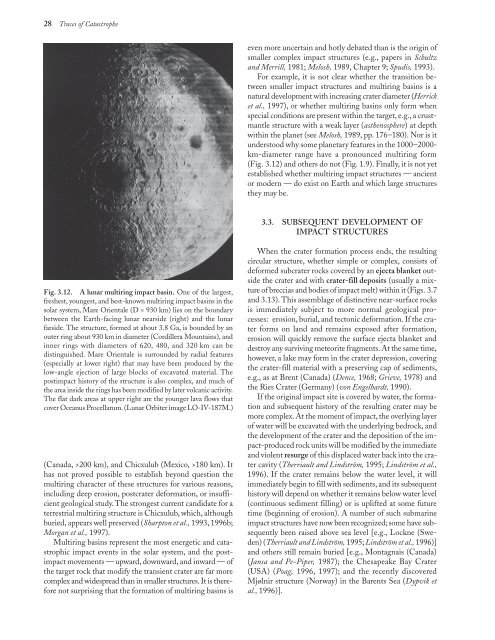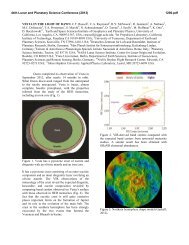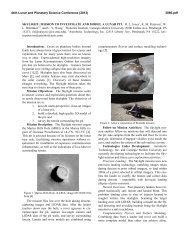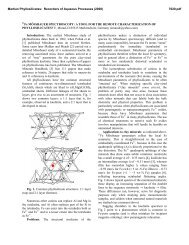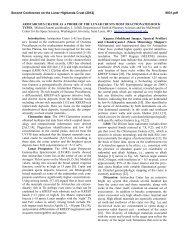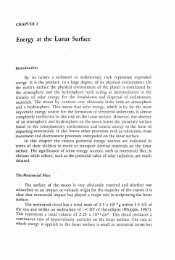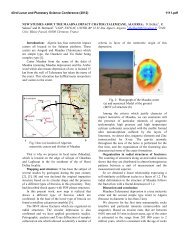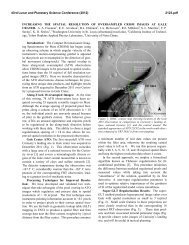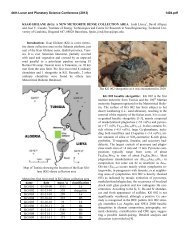Formation of Impact Craters - Lunar and Planetary Institute
Formation of Impact Craters - Lunar and Planetary Institute
Formation of Impact Craters - Lunar and Planetary Institute
You also want an ePaper? Increase the reach of your titles
YUMPU automatically turns print PDFs into web optimized ePapers that Google loves.
28 Traces <strong>of</strong> Catastrophe<br />
Fig. 3.12. A lunar multiring impact basin. One <strong>of</strong> the largest,<br />
freshest, youngest, <strong>and</strong> best-known multiring impact basins in the<br />
solar system, Mare Orientale (D = 930 km) lies on the boundary<br />
between the Earth-facing lunar nearside (right) <strong>and</strong> the lunar<br />
farside. The structure, formed at about 3.8 Ga, is bounded by an<br />
outer ring about 930 km in diameter (Cordillera Mountains), <strong>and</strong><br />
inner rings with diameters <strong>of</strong> 620, 480, <strong>and</strong> 320 km can be<br />
distinguished. Mare Orientale is surrounded by radial features<br />
(especially at lower right) that may have been produced by the<br />
low-angle ejection <strong>of</strong> large blocks <strong>of</strong> excavated material. The<br />
postimpact history <strong>of</strong> the structure is also complex, <strong>and</strong> much <strong>of</strong><br />
the area inside the rings has been modified by later volcanic activity.<br />
The flat dark areas at upper right are the younger lava flows that<br />
cover Oceanus Procellarum. (<strong>Lunar</strong> Orbiter image LO-IV-187M.)<br />
(Canada, >200 km), <strong>and</strong> Chicxulub (Mexico, >180 km). It<br />
has not proved possible to establish beyond question the<br />
multiring character <strong>of</strong> these structures for various reasons,<br />
including deep erosion, postcrater deformation, or insufficient<br />
geological study. The strongest current c<strong>and</strong>idate for a<br />
terrestrial multiring structure is Chicxulub, which, although<br />
buried, appears well preserved (Sharpton et al., 1993, 1996b;<br />
Morgan et al., 1997).<br />
Multiring basins represent the most energetic <strong>and</strong> catastrophic<br />
impact events in the solar system, <strong>and</strong> the postimpact<br />
movements — upward, downward, <strong>and</strong> inward — <strong>of</strong><br />
the target rock that modify the transient crater are far more<br />
complex <strong>and</strong> widespread than in smaller structures. It is therefore<br />
not surprising that the formation <strong>of</strong> multiring basins is<br />
even more uncertain <strong>and</strong> hotly debated than is the origin <strong>of</strong><br />
smaller complex impact structures (e.g., papers in Schultz<br />
<strong>and</strong> Merrill, 1981; Melosh, 1989, Chapter 9; Spudis, 1993).<br />
For example, it is not clear whether the transition between<br />
smaller impact structures <strong>and</strong> multiring basins is a<br />
natural development with increasing crater diameter (Herrick<br />
et al., 1997), or whether multiring basins only form when<br />
special conditions are present within the target, e.g., a crustmantle<br />
structure with a weak layer (asthenosphere) at depth<br />
within the planet (see Melosh, 1989, pp. 176–180). Nor is it<br />
understood why some planetary features in the 1000–2000km-diameter<br />
range have a pronounced multiring form<br />
(Fig. 3.12) <strong>and</strong> others do not (Fig. 1.9). Finally, it is not yet<br />
established whether multiring impact structures — ancient<br />
or modern — do exist on Earth <strong>and</strong> which large structures<br />
they may be.<br />
3.3. SUBSEQUENT DEVELOPMENT OF<br />
IMPACT STRUCTURES<br />
When the crater formation process ends, the resulting<br />
circular structure, whether simple or complex, consists <strong>of</strong><br />
deformed subcrater rocks covered by an ejecta blanket outside<br />
the crater <strong>and</strong> with crater-fill deposits (usually a mixture<br />
<strong>of</strong> breccias <strong>and</strong> bodies <strong>of</strong> impact melt) within it (Figs. 3.7<br />
<strong>and</strong> 3.13). This assemblage <strong>of</strong> distinctive near-surface rocks<br />
is immediately subject to more normal geological processes:<br />
erosion, burial, <strong>and</strong> tectonic deformation. If the crater<br />
forms on l<strong>and</strong> <strong>and</strong> remains exposed after formation,<br />
erosion will quickly remove the surface ejecta blanket <strong>and</strong><br />
destroy any surviving meteorite fragments. At the same time,<br />
however, a lake may form in the crater depression, covering<br />
the crater-fill material with a preserving cap <strong>of</strong> sediments,<br />
e.g., as at Brent (Canada) (Dence, 1968; Grieve, 1978) <strong>and</strong><br />
the Ries Crater (Germany) (von Engelhardt, 1990).<br />
If the original impact site is covered by water, the formation<br />
<strong>and</strong> subsequent history <strong>of</strong> the resulting crater may be<br />
more complex. At the moment <strong>of</strong> impact, the overlying layer<br />
<strong>of</strong> water will be excavated with the underlying bedrock, <strong>and</strong><br />
the development <strong>of</strong> the crater <strong>and</strong> the deposition <strong>of</strong> the impact-produced<br />
rock units will be modified by the immediate<br />
<strong>and</strong> violent resurge <strong>of</strong> this displaced water back into the crater<br />
cavity (Therriault <strong>and</strong> Lindström, 1995; Lindström et al.,<br />
1996). If the crater remains below the water level, it will<br />
immediately begin to fill with sediments, <strong>and</strong> its subsequent<br />
history will depend on whether it remains below water level<br />
(continuous sediment filling) or is uplifted at some future<br />
time (beginning <strong>of</strong> erosion). A number <strong>of</strong> such submarine<br />
impact structures have now been recognized; some have subsequently<br />
been raised above sea level [e.g., Lockne (Sweden)<br />
(Therriault <strong>and</strong> Lindström, 1995; Lindström et al., 1996)]<br />
<strong>and</strong> others still remain buried [e.g., Montagnais (Canada)<br />
(Jansa <strong>and</strong> Pe-Piper, 1987); the Chesapeake Bay Crater<br />
(USA) (Poag, 1996, 1997); <strong>and</strong> the recently discovered<br />
Mjølnir structure (Norway) in the Barents Sea (Dypvik et<br />
al., 1996)].


